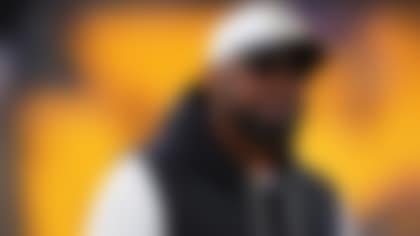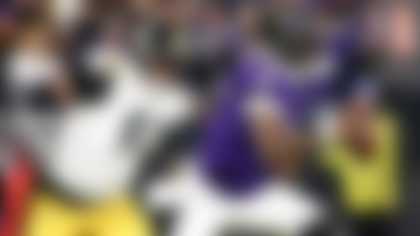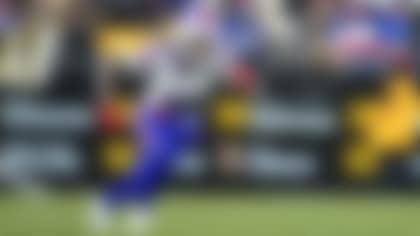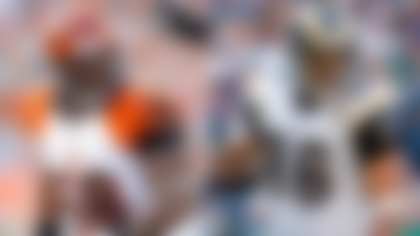A breakdown of Super Bowl XLVI between the Patriots and Giants:
Eli Manning scaled back on his turnovers this season (down from 30 in 2010 to 22 in 2011), and redeemed those extra opportunities for big plays. Leading an offense that ranked fifth in pass plays of 20-plus yards (67), Manning has made precise throws on a consistent basis. Athletic both in and out of the pocket, he can manage any rush by the Patriots.
Tom Brady can make any throw. He is decisive, accurate and anticipates receivers coming open versus both zone and man coverages. Brady can be reduced to mortal status, however, when forced to move off his spot. The Giants' pass rush, combined with tight man-to-man coverage, could make life more difficult for Brady. Then again, the Patriots' signal-caller should rise to the occasion.
While Brandon Jacobs flourishes more in one-cut-and-go, zone-blocking schemes, Ahmad Bradshaw has the ability to find yardage in any situation -- behind a Giants offensive line that has been ever-changing. He can stop and redirect at the drop of a hat and could pose a problem for an inconsistent group of Patriot tacklers. Bradshaw also is a threat underneath as a receiver, leaking out of the backfield late.
Ahmad Bradshaw
BenJarvus Green-Ellis and Danny Woodhead aren't going to make many plays for themselves. Their job is to trust the blocking scheme and hit the required hole. Against the Giants' disciplined linebacking corps, Green-Ellis' ability to remain disciplined could keep the Patriots on-schedule offensively. In the screen game, Woodhead's ability to create in open space could counter New York's pass rush.
Hakeem Nicks missed the Giants' Week 9 win over the Patriots, forcing the Giants to play more with two-tight end sets. With Nicks joining Victor Cruz and Mario Manningham, New York can spread it out with the NFL's most polished receiving trio. Manning's improved ball placement also has upped their yards after the catch. Don't forget about Jake Ballard, either; he 67 yards receiving and a touchdown against the Pats earlier this season.
Tight ends Rob Gronkowski and Aaron Hernandez force defenses to make personnel decisions on early downs, and pass or run, New England has an advantage. At the same time, the Patriots need a play over the top from their outside receivers (Chad Ochocinco and Deion Branch) to counter a Giants D that has defended the middle of the field well this postseason. Gronkowski's questionable health (ankle injury in the AFC Championship Game) also will affect this unit's effectiveness.
There is nothing elite about the Giants' front five, but Manning and Bradshaw have made the most of their situation behind an evolving unit. Will Beatty is subtracted from the group that beat the Patriots, and David Diehl is at left tackle with Kevin Boothe at guard. They put a hat on a hat, and even though his linemen aren't explosive off the ball, Bradshaw can play off of them and find yards.
With Sebastian Vollmer's return at right tackle, a solid group gets a boost heading into a tough matchup against the Giants' edge rushers. When the Giants put four defensive ends on the field, the veteran presence of Logan Mankins and Brian Waters at guard could help the Patriots pick up stunts and win one-on-one battles inside. Added depth also allows New England to employ rookie Nate Solder as an extra blocker in run packages.
In the playoffs alone, the Giants have used 27 different combinations with their four defensive linemen. Rotating so many bodies in and out, defensive coordinator Perry Fewell is able to keep his rushers fresh, lightening the load on the back seven and masking some of the Giants' deficiencies at linebacker and defensive back in pass coverage. No defensive front has more of an impact on their team than this one.
After Andre Carter's injury in Week 15, the Patriots pared their four-man front down to a 3-4 alignment. With this shift from pass rushers to two-gappers, New England has been stouter against the run and hasn't allowed a 100-yard rusher since Week 16. Kyle Love, Vince Wilfork and Brandon Deaderick aren't the quickest, but they could prove immoveable for a Giants offense that wants to establish the run.
Chase Blackburn and Michael Boley won't wow you, but they read their keys well and communicate in coverage. Those two, along with rookie Jacquian Williams, will be under pressure to jam and re-route the Patriots' tight ends. Gronkowski and Hernandez will test them with intermediate crossing routes, but if they are locked up, that gives the Giants' pass rush an extra second to sack Brady.
Michael Boley
The Patriots' second-level players are extremely tied to their front three and its ability to eat up blockers. While Jerod Mayo & Co. are athletic, they do not get off of blocks well. If New England's 300-pounders don't occupy up front, the Giants have an offensive line that excels at doubling at the point of attack and peeling off to lock-up a linebacker on the second level.
Expect the Giants to play lots of man-to-man, like they did in the first matchup, and hope for a rush from their front four. In their win over the Patriots, the Giants held Brady to a 39 percent completion rate against man coverage, including 38.4 percent when they didn't blitz. If the Giants' pass rush is in-sync with its coverage, re-routing at the line with safeties over the top, Brady's windows will be tight.
The Patriots cannot play man coverage without bringing pressure. When New England combined blitzes with man coverage in Week 9, Manning was 4-for-14; when they didn't blitz, he went 8-for-11. New England's 31st-ranked secondary is full of holes, but it gave up the second-fewest 20-plus yard touchdowns (5) this season. The Patriots will have to be sure tacklers, though, as New York's wideouts are dangerous after the catch.
The Giants have to feel good about Lawrence Tynes after he hit the game-winning field goal in the NFC Championship Game. But they also will need deep kickoffs to avoid spotting Brady any yards. Will Blackmon and Devin Thomas are not going to flip the field for the Giants' offense (they only had one return of more than 40 yards this season).
Lawrence Tynes
Stephen Gostkowski and Zoltan Mesko are solid anchors in the kicking game. The Patriots have the fourth-best starting field position allowed (20.8 yard line) after kickoffs, and Mesko has allowed a punt return average of only 8.5 yards. That duo will be a key to give New England's secondary a bit more leeway versus an explosive pass offense.
Tom Coughlin is going to let his players play. We don't expect a whole lot of exotic scheme from such a conservative coach. The Giants will run what they have all season, and look to establish the run, take their deep shots and play man-to-man on defense with a smattering of blitzes. Most of his coaching has been completed in simply getting this team to Indianapolis.
If any coach can learn from a regular season loss and turn what he finds on tape into an advantage in the rematch, it's Bill Belichick. It will be interesting to see how the Patriots' offense adjusts to a defense that went man-to-man against its receivers in the regular season. Expect lots of movement and bunch formations to create rubs and give Brady underneath options.
For more analysis on Super Bowl XLVI, watch "Playbook" -- the ultimate football Xs and Os show -- on Wednesday, Thursday or Friday at 6 p.m. ET on NFL Network. Check the NFL Network broadcast schedule for further details. Follow "Playbook" on Twitter _@NFLNPlaybook_.



